外研版(2019)必修 第一册Unit 6 At one with nature Using language课件(共43张PPT)
文档属性
| 名称 | 外研版(2019)必修 第一册Unit 6 At one with nature Using language课件(共43张PPT) | 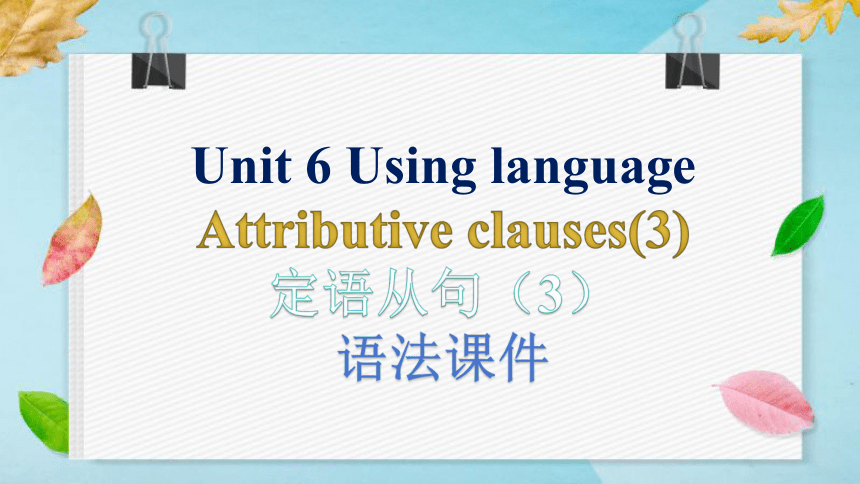 | |
| 格式 | pptx | ||
| 文件大小 | 10.5MB | ||
| 资源类型 | 教案 | ||
| 版本资源 | 外研版(2019) | ||
| 科目 | 英语 | ||
| 更新时间 | 2024-10-09 22:26:14 | ||
图片预览

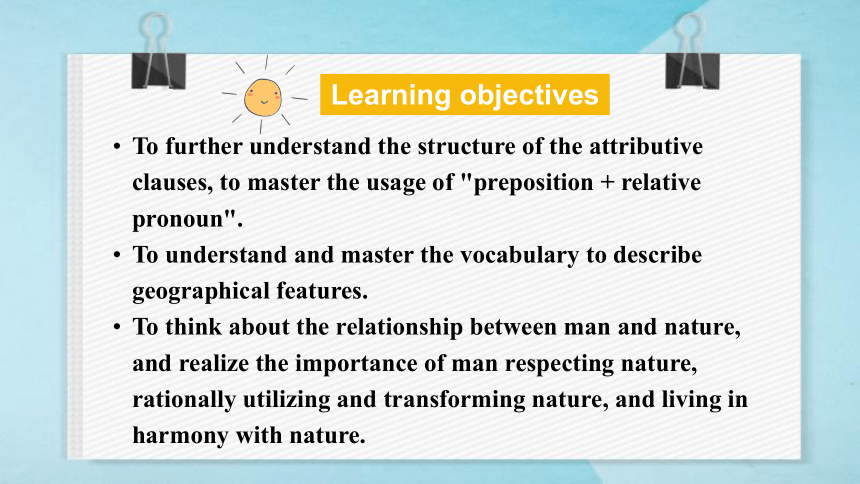
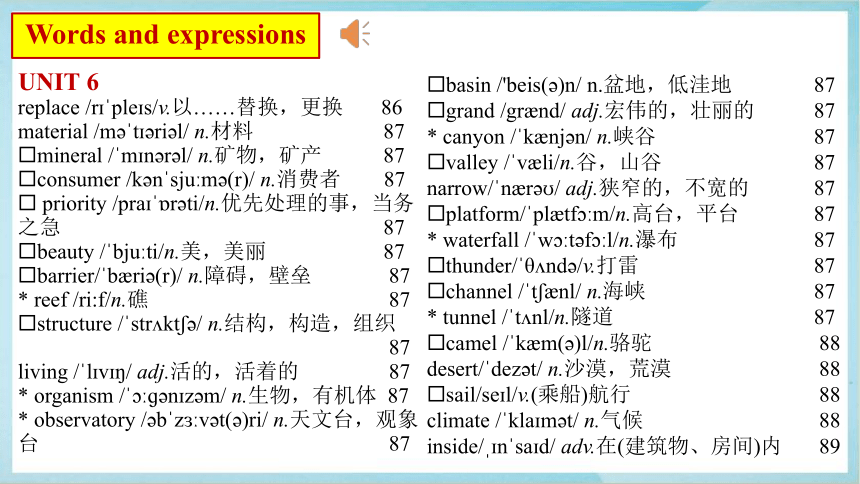
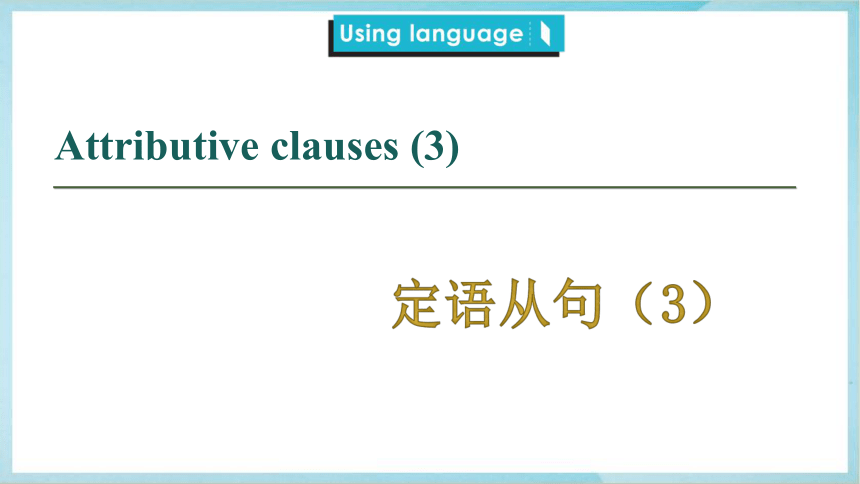
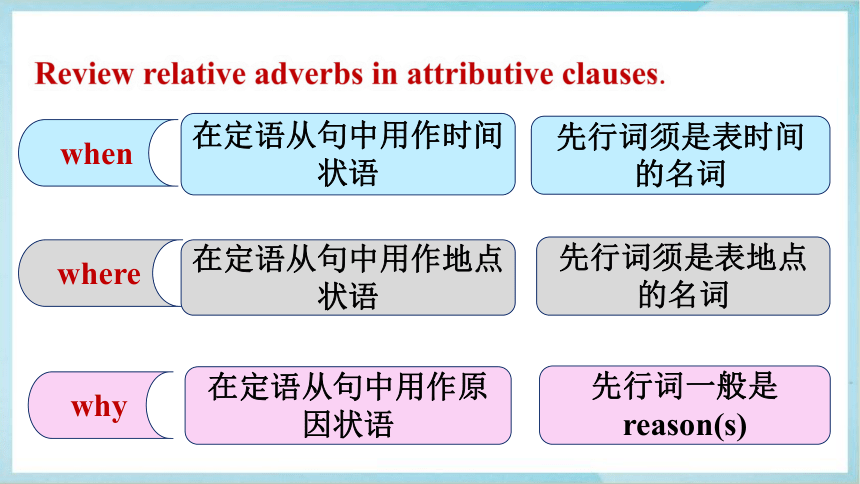
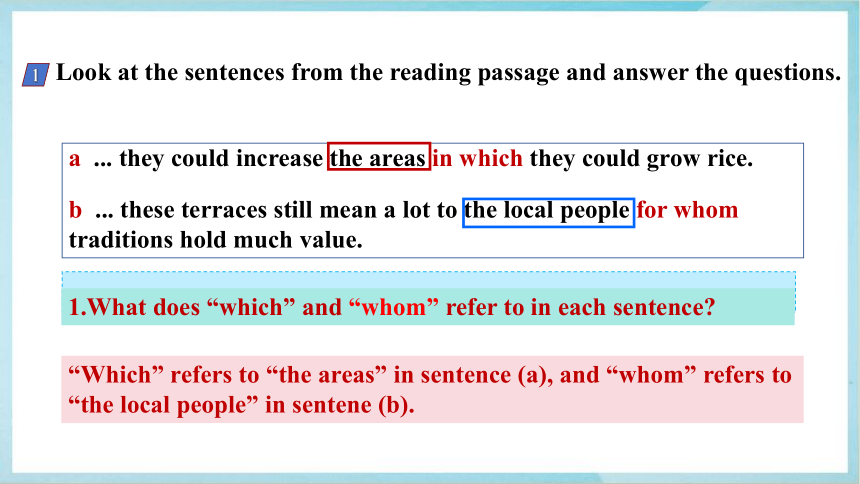
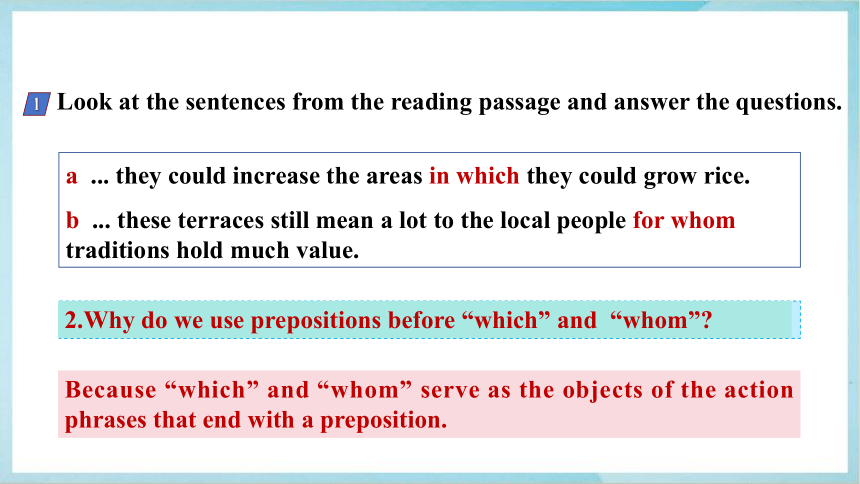
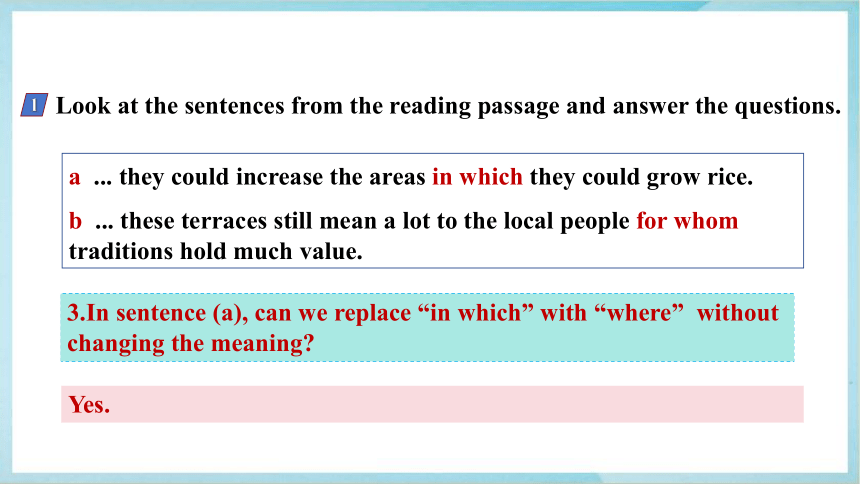


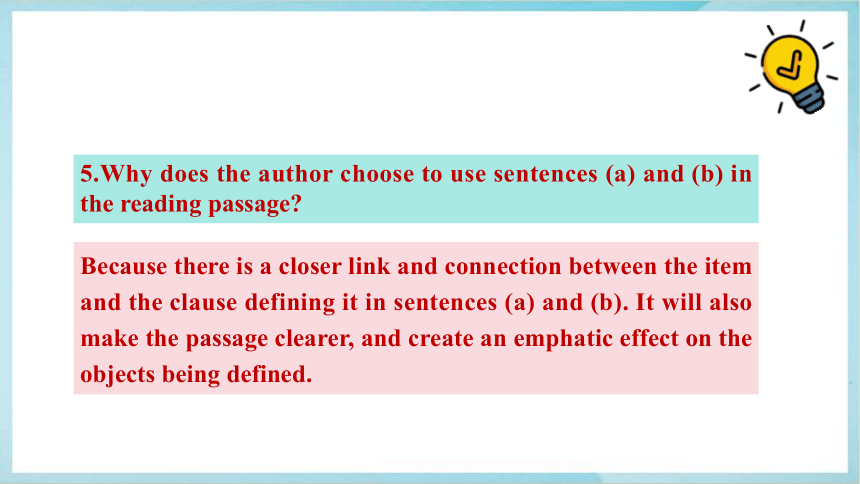
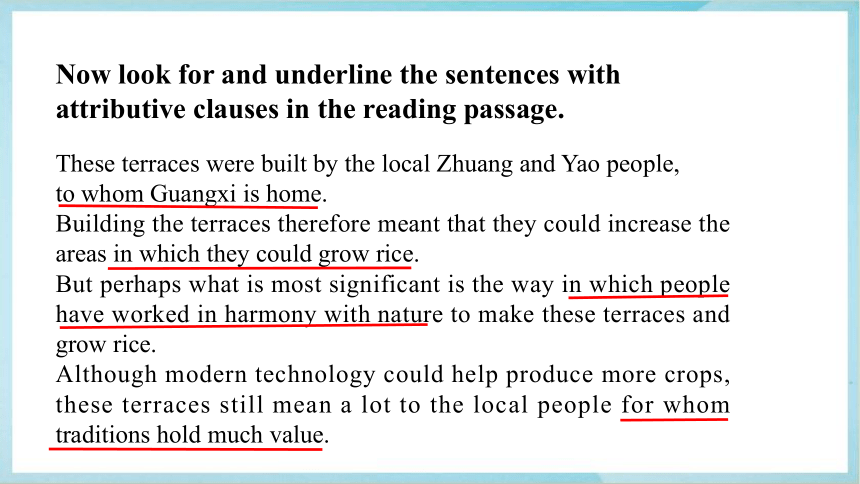
文档简介
(共43张PPT)
Unit 6 Using language
Attributive clauses(3)
定语从句(3)
语法课件
To further understand the structure of the attributive clauses, to master the usage of "preposition + relative pronoun".
To understand and master the vocabulary to describe geographical features.
To think about the relationship between man and nature, and realize the importance of man respecting nature, rationally utilizing and transforming nature, and living in harmony with nature.
Learning objectives
UNIT 6
replace /r ple s/v.以……替换,更换 86
material /m t ri l/ n.材料 87
mineral / m n r l/ n.矿物,矿产 87
consumer /k n sju m (r)/ n.消费者 87
priority /pra r ti/n.优先处理的事,当务之急 87
beauty / bju ti/n.美,美丽 87
barrier/ b ri (r)/ n.障碍,壁垒 87
* reef /ri:f/n.礁 87
structure / str kt / n.结构,构造,组织
87
living / l v / adj.活的,活着的 87
* organism / ɡ n z m/ n.生物,有机体 87
* observatory / b z v t( )ri/ n.天文台,观象台 87
Words and expressions
basin /'beis( )n/ n.盆地,低洼地 87
grand /gr nd/ adj.宏伟的,壮丽的 87
* canyon / k nj n/ n.峡谷 87
valley / v li/n.谷,山谷 87
narrow/ n r / adj.狭窄的,不宽的 87
platform/ pl tf m/n.高台,平台 87
* waterfall / w t f l/n.瀑布 87
thunder/ θ nd /v.打雷 87
channel / t nl/ n.海峡 87
* tunnel / t nl/n.隧道 87
camel / k m( )l/n.骆驼 88
desert/ dez t/ n.沙漠,荒漠 88
sail/se l/v.(乘船)航行 88
climate / kla m t/ n.气候 88
inside/ n sa d/ adv.在(建筑物、房间)内 89
Attributive clauses (3)
_____________________________________________________________________
定语从句(3)
where
在定语从句中用作地点状语
先行词须是表时间的名词
when
在定语从句中用作原因状语
在定语从句中用作时间状语
先行词须是表地点的名词
先行词一般是reason(s)
why
Review relative adverbs in attributive clauses.
Look at the sentences from the reading passage and answer the questions.
1.What does “which” and “whom” refer to in each sentence
a ... they could increase the areas in which they could grow rice.
b ... these terraces still mean a lot to the local people for whom traditions hold much value.
1
“Which” refers to “the areas” in sentence (a), and “whom” refers to “the local people” in sentene (b).
Look at the sentences from the reading passage and answer the questions.
2.Why do we use prepositions before “which” and “whom”
a ... they could increase the areas in which they could grow rice.
b ... these terraces still mean a lot to the local people for whom traditions hold much value.
1
Because “which” and “whom” serve as the objects of the action phrases that end with a preposition.
3.In sentence (a), can we replace “in which” with “where” without changing the meaning
a ... they could increase the areas in which they could grow rice.
b ... these terraces still mean a lot to the local people for whom traditions hold much value.
Yes.
Look at the sentences from the reading passage and answer the questions.
1
指人
指物
介词 + whom
介词 + which
介词 + 关系代词
Summary
c ... they could increase the areas. They could grow rice in these areas.
d ... these terraces still mean a lot to the local people. Traditions hold much value for them.
Compare them with the following sentences and answer the questions.
4.What is the difference between the two groups of sentences
Sentences (a) and (b) both contain a clause defining a noun in the sentence.
Sentences (c) and (d) are constructed with a pair of simple sentences, with one defining a noun in the other sentence in each pair.
5.Why does the author choose to use sentences (a) and (b) in the reading passage
Because there is a closer link and connection between the item and the clause defining it in sentences (a) and (b). It will also make the passage clearer, and create an emphatic effect on the objects being defined.
Now look for and underline the sentences with attributive clauses in the reading passage.
These terraces were built by the local Zhuang and Yao people,
to whom Guangxi is home.
Building the terraces therefore meant that they could increase the areas in which they could grow rice.
But perhaps what is most significant is the way in which people have worked in harmony with nature to make these terraces and grow rice.
Although modern technology could help produce more crops, these terraces still mean a lot to the local people for whom traditions hold much value.
This knowledge is passed down through families, which means that new generations continue to use ancient methods of agriculture to maintain the terraces.
Today, the Longji Rice Terraces attract thousands of visitors who come to admire this great wonder created by people and nature working together.
Now look for and underline the sentences with attributive clauses in the reading passage.
单元语法 定语从句(Ⅲ)
“介词+ 关系代词”引导定语从句
要点一 “介词+ 关系代词”引导的定语从句
关系副词when,where,why 引导定语从句时,它们也可用“介词+ 关系代词(which / whom)”代替。
在“介词+ 关系代词”引导的定语从句中,关系代词只能用which 或whom,不可用that 或who。先行词指物时用which,先行词指人时用whom。
( 1)介词选择的三原则:一先二动三意义。
一先:根据先行词的搭配习惯来确定。
二动:根据从句中谓语动词的搭配习惯来确定。
三意义:根据从句所表达的意义来确定。
【误区警示】
表“所属关系”或“整体中的一部分”时, 常用... of which/ whom 引导定语从句。
( 2)介词可后移,此时关系代词可省略(省 略时,介词必须后移)。
【误区警示】
有些含有介词的固定动词短语一般不能将介词单独放在关系代词前,如listen to,look for,care for,hear from,hear of, take care of 等。
(3)“名词/ 代词/ 数词 +of + 关系代词” 引导的定语从句通常是非限制性定语从句,该结构在定语从句中一般作主语。
(4)“介词+whose”在定语从句中作定语, 修饰其后的名词。
单句语法填空
(1)I remember
the day which I settled in China.
the days which I lived here.
the month which I stayed there.
on
during
in
(2)This is the book
which I spent 5 dollars.
which I paid 5 dollars.
which I learnt a lot.
which Tom often talks.
(3)My computer, which I can’t surf the Internet,crashed yesterday.
同义句转换
(4)This is the man to whom you could turn for help.
This is the man you could for help.
on
for
from
about
without
whom
turn to
要点二 关系副词与“介词+ 关系代词”的替换
(1)when =at / in / during / on + which
(2)where =in / at / on + which
(3)why =for + which
同义句转换
(1)The date when I joined the army was October 12,1960.
The date I joined the army was October 12, 1960.
(2)The house in which Mark lived is now a library.
The house Mark lived is now a library.
(3)Is that the reason why she suddenly changed her mind
Is that the reason she suddenly changed her mind
on which
where
for which
要点三 where 引导的定语从句与状语从句的区别
判断下列句中的where 从句是定语从句还是状语从句
(1)Is there a shop around where(=in which)I can blow my bike
tyres up _________________
(2)Where there is a will,there is a way._________________
(3)We should go where we are needed. _________________
引导定语从句 引导状语从句
where的作用 关系副词 从属连词
修饰谁 前面的地点名词 主句或主句谓语动词
替换“介词+which” 能 不能
位置 主句之后或主句中间 主句之前或主句之后
定语从句
地点状语从句
地点状语从句
The man______________ the thief was caught was a good policeman.
This is the reason ______________ I was praised by my chemistry teacher.
Exercise
by whom
for which
含有介词的动词固定短语在定语从句中一般不拆开,在这种情况下,介词仍然放在后面,例如 hear from, look after 等。
3) I met the child ___________________ I looked after ten years ago.
4) I wanted to visit the house ____________my grandparents lived in.
介词处于句尾时,句中的关系代词可以省略。
(who / whom / that)
(that / which)
Exercise
Connect the sentences with a preposition + whom / which.
2. Guangxi is a province. The Longji Rice Terraces
are located in it.
The Zhuang is an ethnic group, of which the population is the largest of all ethnic groups in China.
Guangxi is a province in which the Longji Rice Terraces are located.
1. The Zhuang is an ethnic group. Its population is
the largest of all ethnic groups in China.
2
4. He is an expert on rice planting. The local Zhuang
people have learnt a lot from him.
I want to visit this cultural landscape, to which the title of UNESCO World Heritage Site was given in 2016.
He is an expert on rice planting, from whom the local Zhuang people have learnt a lot.
3. I want to visit this cultural landscape. The title of
UNESCO World Heritage Site was given to it in 2016.
Connect the sentences with a preposition + whom / which.
2
Complete the passage with a preposition + whom / which. (P87)
3
Among the many beautiful treasures people can receive from nature are natural dyes. The most common natural source 1___________ natural dyes come is plants. Materials for making natural dyes can often be found in gardens 2________ colorful flowers are planted. Other natural dyes are made from insects, sea creatures and mineral compounds.
在人们可以从大自然中得到的许多美丽的宝藏中,天然染料是其中之一。天然染料最常见的天然来源是植物。制作天然染料的材料通常可以在花园里找到,花园里种着五颜六色的花。其他天然染料是由昆虫、海洋生物和矿物化合物制成的。
from which
in which
Complete the passage with a preposition + whom / which. (P87)
3
Natural dyes are now returning to popularity, especially with artists and craftspeople. The reasons 3 ___________ they prefer natural dyes are that the colors are brighter and can be kept longer. Natural dyes are also becoming more popular with consumers 4 ________ caring for the environment is a priority. More and more people feel that by using natural dyes, we can remind ourselves of nature’s beauty and protect the natural world.
天然染料现在又重新流行起来,尤其受到艺术家和手工艺人的欢迎。他们喜欢天然染料的原因是颜色更鲜艳,可以保存更久。天然染料也越来越受到重视环保的消费者的欢迎。越来越多的人觉得通过使用天然染料,我们可以提醒自己大自然的美丽,保护自然世界。
for which
for whom
Complete the passage with a preposition + whom / which. (P87)
3
Geographical features
_____________________________________________________________________
地理特征
Read the descriptions and match them to the pictures. (P88)
a
c
d
b
4
Complete the email with the words in bold in Activity 4. (P88)
5
Hi Jane,
I’m now back in the hotel after a fantastic day exploring Huangguoshu National Park. The park is most famous for its 1 ____________. Check out this video that I made – it shows the water falling into the deep 2 _______ below.
Next week we are flying to the Turpan 3 ________ in Xinjiang, which is famous for its sweet grapes. I’ve heard that grapes are dried in drying houses to make raisins. The walls of the houses have a lot of holes in them to allow wind to pass through. How clever! We are also going to ride camels, “the ships of the desert”. It sounds like I will be sailing on a(n) 4 _________ of sand!
See you soon.
Emma
waterfall
valley
Basin
sea / ocean
5
Complete the email with the words in bold in Activity 4. (P88)
6
Work in pairs.Talk about other geographical features in the world. (P88)
Life in different climate zones
_____________________________________________________________________
生活在不同的气候带
Life in different climate zone 生活在不同的气候带
Around four million people live in the Arctic region, of whom around 170,000 are Inuit.
In the Arctic, the temperature can reach as low as -70 ℃.
The Arctic includes parts of eight countries: Canada, Russia, the United States, Denmark, Norway, Iceland, Sweden and Finland.
大约有400万人生活在北极地区,其中约17万人是因纽特人。
在北极,气温可低至零下70摄氏度。
北极包括八个国家的部分地区:加拿大、俄罗斯、美国、丹麦、挪威、冰岛、瑞典和芬兰。
Did You Know
arctic[ ɑ kt k] adj. 北极的; 严寒的,极冷的;
Inuit[ nju t] n. 因纽特人(爱斯基摩人Eskimo)
When you hear a word that you don’t recognize, don’t panic! Try to note down how it sounds, and keep listening. When you have finished listening, try to work out the meaning from the context of the word.
当你听到一个不认识的单词时,不要惊慌!试着记下它的发音,然后继续听。当你听完后,试着从单词的上下文中找出它的意思。
Learning to learn
P89
c
d
b
a
e
b, d, e
c
7
Listen to a girl talking about Inuit life and identify the things that are mentioned. (P89)
Identify(find out) the language the girl uses to discuss advantages and disadvantages.
building materials
be kept
fight the cold
cold weather
time
boring
job opportunities
polluted
8
Listen again and complete the table. (P89)
Marly: My name's Marly. I'm from an Inuit village in the far north of Canada. Our lives are closely connected to the natural world of the Arctic.
Although we live in regular houses, we stay in temporary shelters called "igloos"when we go hunting. Igloos are made of snow or ice. On the one hand, they are quite warm inside and the building materials can be found everywhere. But on the other, they can only be kept for around 50 days.
We get our food from the nearby sea.Eating a lot of fish and meat keeps our bodies strong so that we can fight the cold.But the downside is that the cold weather makes it difficult for us to grow enough vegetables and fruit.
Listening Material 听力材料
It's completely dark here for three months of the year, which is a period called"polar night".So,life can sometimes be boring! But the good thing is, during that time the elders tell us stories about our people. It gives us more time to be with our family and friends.
Nowadays,ships bring tourists to the Arctic. The advantage to this is that it brings more money and job opportunities, but the disadvantage is that our environment is being polluted.
One thing is for sure, though: no matter how things change, our traditions will remain an important part of our lives.
Listening Material听力材料
student A
You live in the tropics. Talk about your life with Student B from the Arctic.
Advantages of living in the tropics:
It’s usually warm all year round.
It’s easy to grow food.
The jungles are full of beautiful plants and animals.
Disadvantages of living in the tropics:
It can get too hot to go outside.
There are tropical storms.
Food can go bad quickly.
9
Work in pairs.Talk about life in the tropics and the Arctic. (P89)
student B
You live in the Arctic. Talk about your life with Student A from the tropics.
Advantages of living in the Arctic:
The Northern Lights are amazing.
Food can be preserved for a long time.
It’s not too crowded.
Disadvantages of living in the Arctic:
It gets very cold and is dark during much of the year.
Fruit and vegetables don’t grow naturally.
Life can sometimes be boring and dull.
9
Work in pairs.Talk about life in the tropics and the Arctic. (P89)
My mother found a sheet of paper _______ _______ she wanted to wrap that pack of candies.
Sandstorms often hit this region, ______ therefore has made the soil there become desert.
Experts in agriculture say chemical fertilizers ___________ enable crops to grow faster may harm the soil.
The company has designed a service system ______ ______ its consumers can enjoy three guarantees(保证).
with which
which
that/which
in/under which
Exercises
5. The professor ______ was attracted by the Grand Canyon in this region observed the waterfall in the steep valley.
6. The expert designed a solution _________ could prevent soil loss by planting trees in the desert.
7. She stared at a shallow sheet of frost ahead ______ ______ some small living creatures were moving.
8. Experts give priority to solar energy with ______ we can replace this material.
9. Someone ______ has green fingers can grow sunflowers because they are very expert at agriculture.
10. This herb has a pleasant flavour __________ is of great benefit to the disease.
who
that/which
on which
which
who
that/which
Review the points from the lesson and complete the exercises.
Work in pairs. Talk about the differences between life in southern China and northern China.
Homework
Unit 6 Using language
Attributive clauses(3)
定语从句(3)
语法课件
To further understand the structure of the attributive clauses, to master the usage of "preposition + relative pronoun".
To understand and master the vocabulary to describe geographical features.
To think about the relationship between man and nature, and realize the importance of man respecting nature, rationally utilizing and transforming nature, and living in harmony with nature.
Learning objectives
UNIT 6
replace /r ple s/v.以……替换,更换 86
material /m t ri l/ n.材料 87
mineral / m n r l/ n.矿物,矿产 87
consumer /k n sju m (r)/ n.消费者 87
priority /pra r ti/n.优先处理的事,当务之急 87
beauty / bju ti/n.美,美丽 87
barrier/ b ri (r)/ n.障碍,壁垒 87
* reef /ri:f/n.礁 87
structure / str kt / n.结构,构造,组织
87
living / l v / adj.活的,活着的 87
* organism / ɡ n z m/ n.生物,有机体 87
* observatory / b z v t( )ri/ n.天文台,观象台 87
Words and expressions
basin /'beis( )n/ n.盆地,低洼地 87
grand /gr nd/ adj.宏伟的,壮丽的 87
* canyon / k nj n/ n.峡谷 87
valley / v li/n.谷,山谷 87
narrow/ n r / adj.狭窄的,不宽的 87
platform/ pl tf m/n.高台,平台 87
* waterfall / w t f l/n.瀑布 87
thunder/ θ nd /v.打雷 87
channel / t nl/ n.海峡 87
* tunnel / t nl/n.隧道 87
camel / k m( )l/n.骆驼 88
desert/ dez t/ n.沙漠,荒漠 88
sail/se l/v.(乘船)航行 88
climate / kla m t/ n.气候 88
inside/ n sa d/ adv.在(建筑物、房间)内 89
Attributive clauses (3)
_____________________________________________________________________
定语从句(3)
where
在定语从句中用作地点状语
先行词须是表时间的名词
when
在定语从句中用作原因状语
在定语从句中用作时间状语
先行词须是表地点的名词
先行词一般是reason(s)
why
Review relative adverbs in attributive clauses.
Look at the sentences from the reading passage and answer the questions.
1.What does “which” and “whom” refer to in each sentence
a ... they could increase the areas in which they could grow rice.
b ... these terraces still mean a lot to the local people for whom traditions hold much value.
1
“Which” refers to “the areas” in sentence (a), and “whom” refers to “the local people” in sentene (b).
Look at the sentences from the reading passage and answer the questions.
2.Why do we use prepositions before “which” and “whom”
a ... they could increase the areas in which they could grow rice.
b ... these terraces still mean a lot to the local people for whom traditions hold much value.
1
Because “which” and “whom” serve as the objects of the action phrases that end with a preposition.
3.In sentence (a), can we replace “in which” with “where” without changing the meaning
a ... they could increase the areas in which they could grow rice.
b ... these terraces still mean a lot to the local people for whom traditions hold much value.
Yes.
Look at the sentences from the reading passage and answer the questions.
1
指人
指物
介词 + whom
介词 + which
介词 + 关系代词
Summary
c ... they could increase the areas. They could grow rice in these areas.
d ... these terraces still mean a lot to the local people. Traditions hold much value for them.
Compare them with the following sentences and answer the questions.
4.What is the difference between the two groups of sentences
Sentences (a) and (b) both contain a clause defining a noun in the sentence.
Sentences (c) and (d) are constructed with a pair of simple sentences, with one defining a noun in the other sentence in each pair.
5.Why does the author choose to use sentences (a) and (b) in the reading passage
Because there is a closer link and connection between the item and the clause defining it in sentences (a) and (b). It will also make the passage clearer, and create an emphatic effect on the objects being defined.
Now look for and underline the sentences with attributive clauses in the reading passage.
These terraces were built by the local Zhuang and Yao people,
to whom Guangxi is home.
Building the terraces therefore meant that they could increase the areas in which they could grow rice.
But perhaps what is most significant is the way in which people have worked in harmony with nature to make these terraces and grow rice.
Although modern technology could help produce more crops, these terraces still mean a lot to the local people for whom traditions hold much value.
This knowledge is passed down through families, which means that new generations continue to use ancient methods of agriculture to maintain the terraces.
Today, the Longji Rice Terraces attract thousands of visitors who come to admire this great wonder created by people and nature working together.
Now look for and underline the sentences with attributive clauses in the reading passage.
单元语法 定语从句(Ⅲ)
“介词+ 关系代词”引导定语从句
要点一 “介词+ 关系代词”引导的定语从句
关系副词when,where,why 引导定语从句时,它们也可用“介词+ 关系代词(which / whom)”代替。
在“介词+ 关系代词”引导的定语从句中,关系代词只能用which 或whom,不可用that 或who。先行词指物时用which,先行词指人时用whom。
( 1)介词选择的三原则:一先二动三意义。
一先:根据先行词的搭配习惯来确定。
二动:根据从句中谓语动词的搭配习惯来确定。
三意义:根据从句所表达的意义来确定。
【误区警示】
表“所属关系”或“整体中的一部分”时, 常用... of which/ whom 引导定语从句。
( 2)介词可后移,此时关系代词可省略(省 略时,介词必须后移)。
【误区警示】
有些含有介词的固定动词短语一般不能将介词单独放在关系代词前,如listen to,look for,care for,hear from,hear of, take care of 等。
(3)“名词/ 代词/ 数词 +of + 关系代词” 引导的定语从句通常是非限制性定语从句,该结构在定语从句中一般作主语。
(4)“介词+whose”在定语从句中作定语, 修饰其后的名词。
单句语法填空
(1)I remember
the day which I settled in China.
the days which I lived here.
the month which I stayed there.
on
during
in
(2)This is the book
which I spent 5 dollars.
which I paid 5 dollars.
which I learnt a lot.
which Tom often talks.
(3)My computer, which I can’t surf the Internet,crashed yesterday.
同义句转换
(4)This is the man to whom you could turn for help.
This is the man you could for help.
on
for
from
about
without
whom
turn to
要点二 关系副词与“介词+ 关系代词”的替换
(1)when =at / in / during / on + which
(2)where =in / at / on + which
(3)why =for + which
同义句转换
(1)The date when I joined the army was October 12,1960.
The date I joined the army was October 12, 1960.
(2)The house in which Mark lived is now a library.
The house Mark lived is now a library.
(3)Is that the reason why she suddenly changed her mind
Is that the reason she suddenly changed her mind
on which
where
for which
要点三 where 引导的定语从句与状语从句的区别
判断下列句中的where 从句是定语从句还是状语从句
(1)Is there a shop around where(=in which)I can blow my bike
tyres up _________________
(2)Where there is a will,there is a way._________________
(3)We should go where we are needed. _________________
引导定语从句 引导状语从句
where的作用 关系副词 从属连词
修饰谁 前面的地点名词 主句或主句谓语动词
替换“介词+which” 能 不能
位置 主句之后或主句中间 主句之前或主句之后
定语从句
地点状语从句
地点状语从句
The man______________ the thief was caught was a good policeman.
This is the reason ______________ I was praised by my chemistry teacher.
Exercise
by whom
for which
含有介词的动词固定短语在定语从句中一般不拆开,在这种情况下,介词仍然放在后面,例如 hear from, look after 等。
3) I met the child ___________________ I looked after ten years ago.
4) I wanted to visit the house ____________my grandparents lived in.
介词处于句尾时,句中的关系代词可以省略。
(who / whom / that)
(that / which)
Exercise
Connect the sentences with a preposition + whom / which.
2. Guangxi is a province. The Longji Rice Terraces
are located in it.
The Zhuang is an ethnic group, of which the population is the largest of all ethnic groups in China.
Guangxi is a province in which the Longji Rice Terraces are located.
1. The Zhuang is an ethnic group. Its population is
the largest of all ethnic groups in China.
2
4. He is an expert on rice planting. The local Zhuang
people have learnt a lot from him.
I want to visit this cultural landscape, to which the title of UNESCO World Heritage Site was given in 2016.
He is an expert on rice planting, from whom the local Zhuang people have learnt a lot.
3. I want to visit this cultural landscape. The title of
UNESCO World Heritage Site was given to it in 2016.
Connect the sentences with a preposition + whom / which.
2
Complete the passage with a preposition + whom / which. (P87)
3
Among the many beautiful treasures people can receive from nature are natural dyes. The most common natural source 1___________ natural dyes come is plants. Materials for making natural dyes can often be found in gardens 2________ colorful flowers are planted. Other natural dyes are made from insects, sea creatures and mineral compounds.
在人们可以从大自然中得到的许多美丽的宝藏中,天然染料是其中之一。天然染料最常见的天然来源是植物。制作天然染料的材料通常可以在花园里找到,花园里种着五颜六色的花。其他天然染料是由昆虫、海洋生物和矿物化合物制成的。
from which
in which
Complete the passage with a preposition + whom / which. (P87)
3
Natural dyes are now returning to popularity, especially with artists and craftspeople. The reasons 3 ___________ they prefer natural dyes are that the colors are brighter and can be kept longer. Natural dyes are also becoming more popular with consumers 4 ________ caring for the environment is a priority. More and more people feel that by using natural dyes, we can remind ourselves of nature’s beauty and protect the natural world.
天然染料现在又重新流行起来,尤其受到艺术家和手工艺人的欢迎。他们喜欢天然染料的原因是颜色更鲜艳,可以保存更久。天然染料也越来越受到重视环保的消费者的欢迎。越来越多的人觉得通过使用天然染料,我们可以提醒自己大自然的美丽,保护自然世界。
for which
for whom
Complete the passage with a preposition + whom / which. (P87)
3
Geographical features
_____________________________________________________________________
地理特征
Read the descriptions and match them to the pictures. (P88)
a
c
d
b
4
Complete the email with the words in bold in Activity 4. (P88)
5
Hi Jane,
I’m now back in the hotel after a fantastic day exploring Huangguoshu National Park. The park is most famous for its 1 ____________. Check out this video that I made – it shows the water falling into the deep 2 _______ below.
Next week we are flying to the Turpan 3 ________ in Xinjiang, which is famous for its sweet grapes. I’ve heard that grapes are dried in drying houses to make raisins. The walls of the houses have a lot of holes in them to allow wind to pass through. How clever! We are also going to ride camels, “the ships of the desert”. It sounds like I will be sailing on a(n) 4 _________ of sand!
See you soon.
Emma
waterfall
valley
Basin
sea / ocean
5
Complete the email with the words in bold in Activity 4. (P88)
6
Work in pairs.Talk about other geographical features in the world. (P88)
Life in different climate zones
_____________________________________________________________________
生活在不同的气候带
Life in different climate zone 生活在不同的气候带
Around four million people live in the Arctic region, of whom around 170,000 are Inuit.
In the Arctic, the temperature can reach as low as -70 ℃.
The Arctic includes parts of eight countries: Canada, Russia, the United States, Denmark, Norway, Iceland, Sweden and Finland.
大约有400万人生活在北极地区,其中约17万人是因纽特人。
在北极,气温可低至零下70摄氏度。
北极包括八个国家的部分地区:加拿大、俄罗斯、美国、丹麦、挪威、冰岛、瑞典和芬兰。
Did You Know
arctic[ ɑ kt k] adj. 北极的; 严寒的,极冷的;
Inuit[ nju t] n. 因纽特人(爱斯基摩人Eskimo)
When you hear a word that you don’t recognize, don’t panic! Try to note down how it sounds, and keep listening. When you have finished listening, try to work out the meaning from the context of the word.
当你听到一个不认识的单词时,不要惊慌!试着记下它的发音,然后继续听。当你听完后,试着从单词的上下文中找出它的意思。
Learning to learn
P89
c
d
b
a
e
b, d, e
c
7
Listen to a girl talking about Inuit life and identify the things that are mentioned. (P89)
Identify(find out) the language the girl uses to discuss advantages and disadvantages.
building materials
be kept
fight the cold
cold weather
time
boring
job opportunities
polluted
8
Listen again and complete the table. (P89)
Marly: My name's Marly. I'm from an Inuit village in the far north of Canada. Our lives are closely connected to the natural world of the Arctic.
Although we live in regular houses, we stay in temporary shelters called "igloos"when we go hunting. Igloos are made of snow or ice. On the one hand, they are quite warm inside and the building materials can be found everywhere. But on the other, they can only be kept for around 50 days.
We get our food from the nearby sea.Eating a lot of fish and meat keeps our bodies strong so that we can fight the cold.But the downside is that the cold weather makes it difficult for us to grow enough vegetables and fruit.
Listening Material 听力材料
It's completely dark here for three months of the year, which is a period called"polar night".So,life can sometimes be boring! But the good thing is, during that time the elders tell us stories about our people. It gives us more time to be with our family and friends.
Nowadays,ships bring tourists to the Arctic. The advantage to this is that it brings more money and job opportunities, but the disadvantage is that our environment is being polluted.
One thing is for sure, though: no matter how things change, our traditions will remain an important part of our lives.
Listening Material听力材料
student A
You live in the tropics. Talk about your life with Student B from the Arctic.
Advantages of living in the tropics:
It’s usually warm all year round.
It’s easy to grow food.
The jungles are full of beautiful plants and animals.
Disadvantages of living in the tropics:
It can get too hot to go outside.
There are tropical storms.
Food can go bad quickly.
9
Work in pairs.Talk about life in the tropics and the Arctic. (P89)
student B
You live in the Arctic. Talk about your life with Student A from the tropics.
Advantages of living in the Arctic:
The Northern Lights are amazing.
Food can be preserved for a long time.
It’s not too crowded.
Disadvantages of living in the Arctic:
It gets very cold and is dark during much of the year.
Fruit and vegetables don’t grow naturally.
Life can sometimes be boring and dull.
9
Work in pairs.Talk about life in the tropics and the Arctic. (P89)
My mother found a sheet of paper _______ _______ she wanted to wrap that pack of candies.
Sandstorms often hit this region, ______ therefore has made the soil there become desert.
Experts in agriculture say chemical fertilizers ___________ enable crops to grow faster may harm the soil.
The company has designed a service system ______ ______ its consumers can enjoy three guarantees(保证).
with which
which
that/which
in/under which
Exercises
5. The professor ______ was attracted by the Grand Canyon in this region observed the waterfall in the steep valley.
6. The expert designed a solution _________ could prevent soil loss by planting trees in the desert.
7. She stared at a shallow sheet of frost ahead ______ ______ some small living creatures were moving.
8. Experts give priority to solar energy with ______ we can replace this material.
9. Someone ______ has green fingers can grow sunflowers because they are very expert at agriculture.
10. This herb has a pleasant flavour __________ is of great benefit to the disease.
who
that/which
on which
which
who
that/which
Review the points from the lesson and complete the exercises.
Work in pairs. Talk about the differences between life in southern China and northern China.
Homework
